
Maja Prešeren
school centre Srečko Kosovel Sežana
Design thinking
Introduction
Teaching marketing an entrepreneurship has always been very challenging and dynamic, but never so fastly evolving as it is nowadays. First the internet and now the social media had already changed the theory behind it. Every study book and a freshly prepared research can be already outdated in the same moment you find it in a book, paper or even on the internet. Challenges are more and more complex and interdisciplinary. If you want to succeed, to be noticed and to place yourself in the complex world market you have to think differently. When you start to develop an idea, you have to picture immediately the impact of your idea. Design is not »ego« centered anymore. It become customer centered. A designer, the ideator of a new product has to »teleport« himself into a body of the customer and understand his needs. Is it possible to teach students to think in this way?
Design Thinking or Brand Strategy?
Ten years ago I came across a book named Design thinking (Integrating Innovation, Customer Experience and Brand Value). I was searching for more information about branding and brand strategy so it intrigued me. I studied it and found some definitions about design thinking.
Design thinking is essentially a human-centered innovation process that emphasizes observation, collaboration, fast learning, visualization of ideas, rapid concept prototyping and concurrent business analysis, which ultimately influences innovation and business strategy.
I was in the middle of an experiment about entrepreneurial learning in general education. I was also designing curricula for a subject entitled Creative Entrepreneurship. And I was asking myself where was the difference between my idea of Creative Entrepreneurship and Design Thinking? And I searched for more. Another definition.
Design thinking is a methodology that provides a solution-based approach to solving problems. It's extremely useful in tackling complex problems that are ill-defined or unknown, by understanding the human needs involved, by re-framing the problem in human/centric ways, by creating many ideas in brainstorming sessions, and by adopting a hands-on approach in prototyping and testing.
And another.
Design thinking is a non-linear, interactive process which seeks to understand users, challenge assumptions, redefine problems and create innovative solutions to prototype and test. The method consists of 5 phases—Empathize, Define, Ideate, Prototype and Test and is most useful when you want to tackle problems that are ill-defined or unknown.
And one more that made me put something in brackets:
Design thinking is a methodology “used by designers” to solve complex problems, and find desirable solutions for clients.
Ok. It is true. It is used by designers and other people without entrepreneurial and marketing knowledge. Entrepreneurship and marketing teachers use the same methodology in teaching since I started in 1998 or even before. And then I found the definition that confirmed my statement.
„However, the more I now ponder design thinking and its methodology, the more intuitively it seems to fit into the world of brand strategy and marketing“. Wayne Atwel, marketing and brand strategist
The most important thing is not to debate how to call this method but to try to teach students to solve problems and real challenges. We practice this simple process when we teach students to do different projects. Every task that they have to do has always 3 parts:
- Inspiration (research, brainstorming, finding the answer to a question WHY should we do something, find the purpose…)
- Ideation (planning, designing, sketching… HOW should we do it)
- Implementation (creation, testing, changing, modifying, evaluation … WHAT did we do? Is it working??? Is the customer satisfied?)
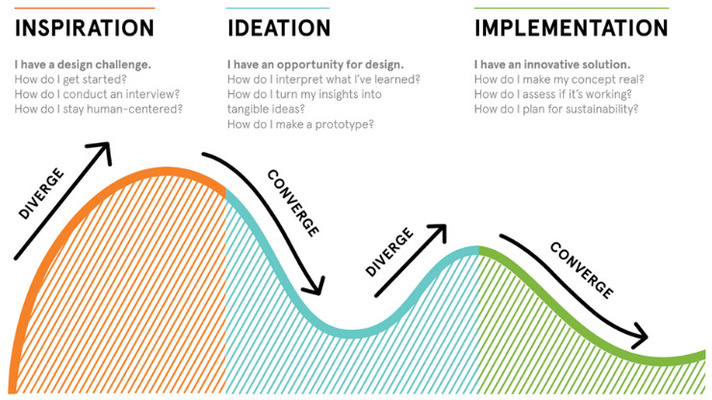
Picture 1: 3 phases of Design thinking
Design thinking method
Since 2008 the design thinking method of teaching entrepreneurial skills became very popular especially among designers. An unexpected gap between designed products and customers’ needs lead to the evolution in thinking about design.
Design thinking has been developed from methods that originally come out of the practice that doesn't focuses only on the final form, but on a principle of developing products and service. (Brown, 2008).
Today's design is not just the finishing touch, which gives a product aesthetic elements that make it more attractive to end users.
Nowadays, in addition to aesthetics, designers focus on usability (Brown, 2008). The main features of design thinking:
- Focusing the end user and try to understand it with different approaches
- Creativity: finding solutions that do not yet exist
- Holistic: solving a problem entirely
- Transdisciplinarity: involvement of individuals with knowledge of new ideas from different fields
- Experimenting: need to try
In the literature, we can see that some mention three phases through which design thinking goes, others extend this process to five phases or even seven phases. The differences occur because some combine several phases into one. Brown (2009) defines the 5 phases:
(1) empathic understanding of the user,
(2) defining the problem,
(3) acquiring and shaping ideas,
(4) prototyping, and
(5) testing.
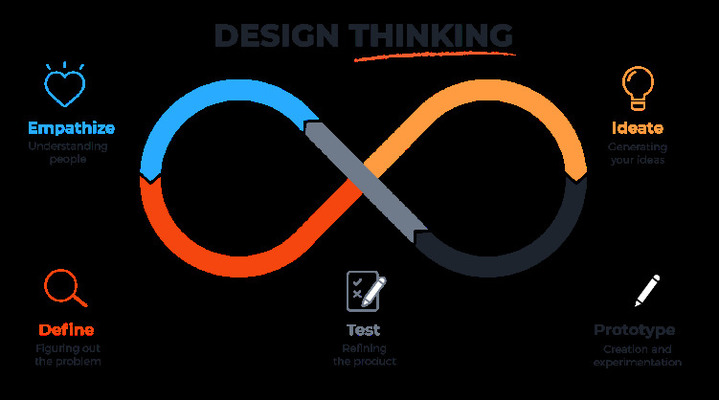
Picture 2: 5 phases of Design thinking
The key stages are understanding the end user, because after all, without an in-depth understanding of users, it is difficult to determine what exactly is the problem we want to solve.
PRESENTATION OF METHOD
PURPOSE: We use design thinking whenever we face complex challenges that involve the individual. Thus, it does not make sense to use design thinking when we face challenges that are easily solvable or that the solutions are closed in nature. It makes sense to use it when we want new, innovative solutions, when we are aware that we will need a longer time until the final solution, so we are not in severe time constraint.
TARGET POPULATION: Design thinking is intended for all who want innovative solutions to challenges encountered. There are no restrictions in what situations it can be used, so it can be used, for example, in the transformation of business models, changes in organizational culture, complex societal challenges (health, education, climate change), problems that affect different stakeholders or change markets and behaviors. We need to keep in mind that design thinking is a longer process and it does not make sense to use it in cases where we want quick solutions.
PROCEDURE OF IMPLEMENTATION: As mentioned above, there are different definitions of how many stages we go through in design thinking. The above are the five stages or below seven stages have the same purpose.
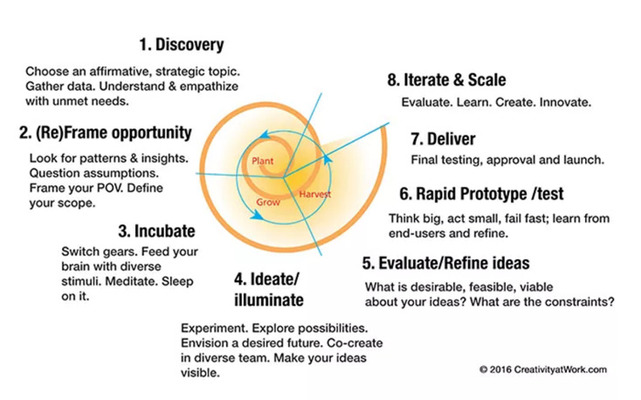
Picture 3: 7 phases of Design thinking
Example of design thinking – Service design – Top Anniversary
The digital tools used during this learning unit were:
and social media:
The inspirational materials we found on the web were:
When we think of design, we usually think about product/industrial design or graphic design. Less commonly we talk about service design. Service design is the activity of planning and organizing people, infrastructure, communication and material components of a service in order to improve its quality and the interaction between the service provider and its users. Service design may function as a way to inform changes to an existing service or create a new service entirely.
TOP OBLETNICA/TOP ANNIVERSARY
At the beggining of the school year a group of students established a mini company (Junior achievement) Xevents. The main activity of a company was the management of events. The runing of a company is a interdisciplinary project that includes 5 subjects: arranging, visual communication, multimedia advertising, marketing and sales promotion. Durring lessons of sales promotion we decided that we cannot wait to get an order for a random event. We decided that we should design a service that can sell. We used the design thinking philosophy.
As ussully we started our project with the first part:
1. INSPIRATION: in this part we had to find our target audience, but before that to define our resources. Our statement was:
- MATERIAL RESORCES: we can use school's spaces for our activity. We can use material and tools.
- HUMAN RESOURCES: our students have different competences (graphic design, video, photo, decorating…)
- CAPITAL: we had 330,00 EUR of initial capital (accuired by selling company stock).
We brainstormed about we could do with this resources and who could be our target audience. The ideas were: movie nights for students, school's disco and other alternative solutions. The Aha! Moment (also known as the Eureka moment) came suddenlly as usual. »Why we don't organize the anniverssary of generations that finished our school?« And imediatelly we hade a wide target audience (40 generations, aproximatelly 100 students per generation and we had a total of 4000 potential customers). Once we had defined our user, we started to emphatise with our user and ask questions:
- What would he like to do or to see after many years in our school? – VISIT OF A SCHOOL
- Who would he like to meet? – THE HEADMASTER; SOME TEACHERS
- What can we offer to satisfy his expectations? – FIND OLD PHOTOS, MAKE NEW PHOTOS, MAKE A VIDEO OF THE GENERATION REUNION AFTER MANY YEARS
By asking questions we defined the problem and we already had the answers, so we started with the second phase:
2. IDEATION: in this part we started to design our service (acquiring and shaping ideas) by giving an interesting name that could become a brand. We chose Top Obletnica that means TOP Anniversary and we shaped the offer and defined the price and decided that we can offer to organize the events on Fridays. We asked the headmaster fort he permission and he agreed. We ask him also if he would be so kind to come to the event and welcome the former students of our school and he was enthusiastic.
So the next step was to prototype, in our case to see if we could find some customers that will appreciate our service. So we entered into the third phase:
3. IMPLEMENTATION: we disigned a flyer and put it on our school's facebook page. The audience of our FB page is broad and it includes former students and parents of our students. We offered our service and waited for reactions. It was the testing phase.

Many people liked the post and we decided to contact them and ask if they are interested. So we had a contact person and a first customer The generation that graduated in 1987. And we had a date: Friday 28th of February 2020. So we designed the invitation, prepared the google document to gather participants data (according to GPR we asked for the permission to take and publish photos), prepared the presentation (What happened in 1987), invited our headmaster and their class teacher, ordered the catering, prepared all the accessories for photography, graduation hats and promotional boards, decorated the school's canteen with the covers of school magazines and photos of the generation 1987, we decorated the catering room and ordered a cake and we ordered t-shirts for the staff, made a deal with a local pub to offer one welcome drink at 22.00 when we decided that our event in the school will be finished …
We really organized the event and it was a success. There were 30 people, their class teacher and the headmaster and they were more than satisfied. We got 2 more orders: Generation 1994 on the 13th of March (cancelled due to Covid-19) and Generation 1990 on the 17th of April (cancelled due to Covid-19).
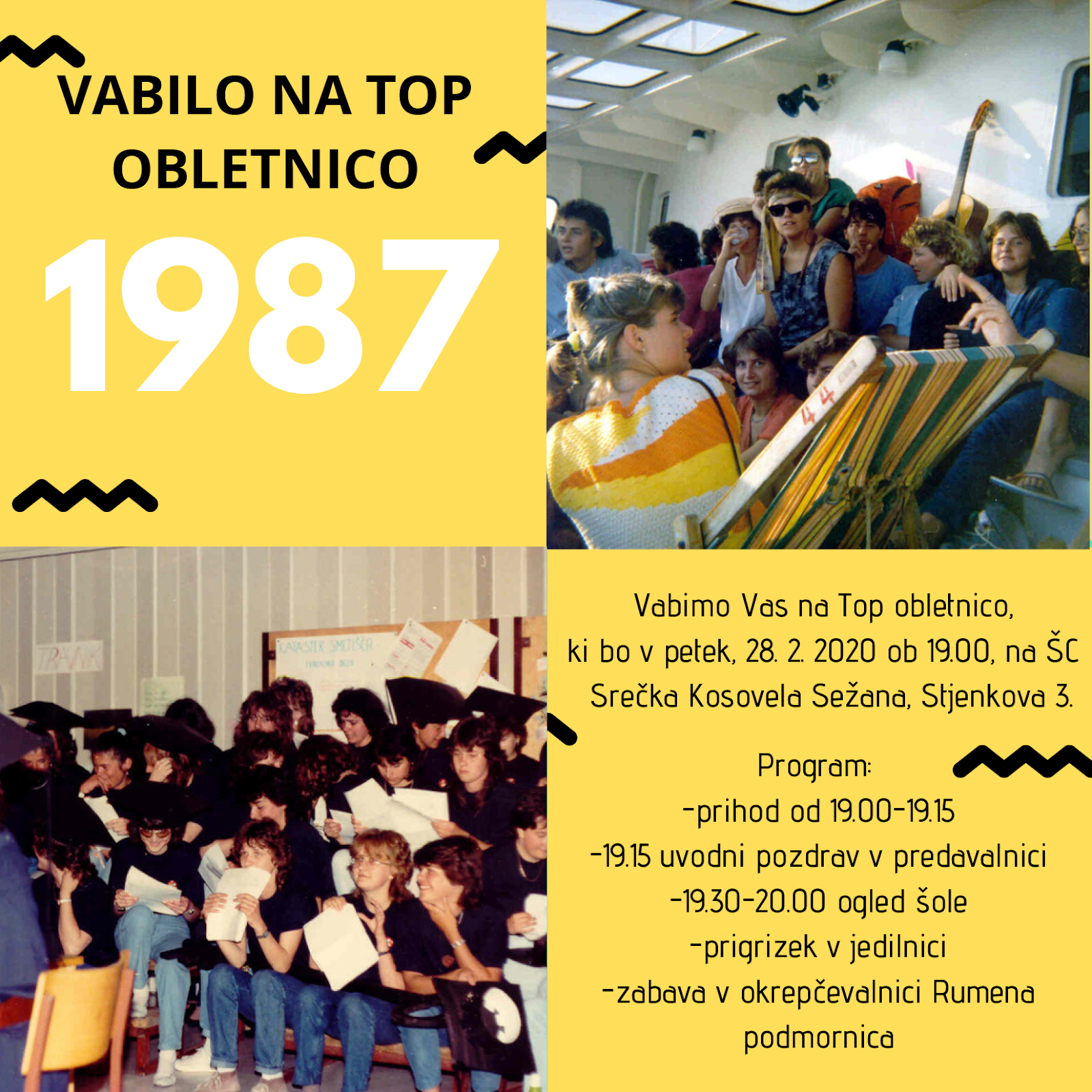

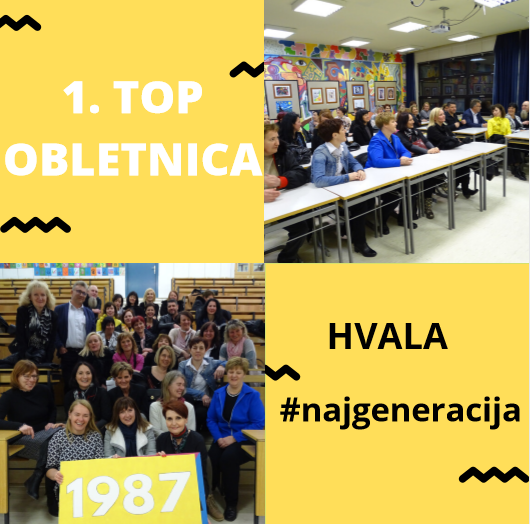
Picture 5: Invitation, decoration, memory
After the event we prepared a video memory and a photo gallery. We evaluated the event and understood that it was planned and organized perfectly and that we have a perfect service. When we did the report we described all the phases and the marketing mix 7-p of our service. (Product/service, Place, Price, Promotion, Physical evidence, Process and People).
Summary
By using this 3 phases when trying to solve a problem you cannot fail. Design thinking or Brand strategy is the right way to work with art students. It teaches them to research, emphasize, design, think implement and be professional.
Students evaluate the learning unit as very good. Here are some statements that point out the competences that they developed (team work, self-consciousness, self-esteem, communication skills, empathy, critical thinking, design thinking, interdisciplinarity):
»We understood each other well, we also learned a lot from each other.
We have built a good communication relationship.
Communication is very important in solving problems.
This experience gave us a lot. We shared the working tasks and were happy to help the others if needed.
We found that teamwork is important, no matter what. By working together strongly and harmoniously, we can create an amazing experience.
During the implementation of activities, we also came up with various new ideas that could help us in the future, as we received the order for two more Top Anniversaries, but unfortunately we were not able to realize them due to the C-19. We believe we would be successful!!!
LITERATURE
Lockwood T., Design thinking, Integrating Innovation, Customer Experience, and Brand Value, 2010 Design Management Institute, New York
Brown T., Design thinking, Harvard Business Review, Magazine, June 2008
Xevents report, Logar K, at al, Sežana, Šolski center Srečka Kosovela Sežana, April 2020
https://www.interaction-design.org/literature/topics/design-thinking
https://psihologijadela.files.wordpress.com/2019/11/jelenc48dic48d_designthinking_nocopy-1.pdf